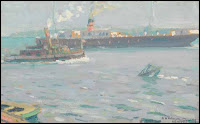Before returning soon to the world of printmaking here's a last selection of some great impressions by painters staying in St.Malo around 1900-1930 that I feel have to include. Finishing in an ordely way this survey. Many
of these names also surface in Paris’ Academie Julian.
Besides a great printmaker Czech Frantisek
Tavik Simon (1877-1942) was also a fine painter discovering the charm and colours of St. Malo’s Victorian holiday life.
Surprisingly many later famous Canadian artist visited St.Malo in the beginning of the XXth century:
Albert Henri Robinson (1881-1965) who painted with a similar to F.T Simon's pallet of wonderful blue-greens (emerald) and lila the sea and lighthouse of St.Malo. And after returning in Canada the ships and port of Montreal.
 His friend A.Y. (Alexander Young) Jackson (1882-1874) who was with him in St.Malo later reported with paint and brushes as an appointed War Artist in WWI after being wounded as a soldier.
His friend A.Y. (Alexander Young) Jackson (1882-1874) who was with him in St.Malo later reported with paint and brushes as an appointed War Artist in WWI after being wounded as a soldier.
Clarence Gagnon (1881-1942) saw the special light and colors of Brittany as he did the decorative and characteristic striped beach tents and parasols. A classic and iconic design and in use and popular to this day.
and Helen
Galloway McNicoll (1879-1915), also a student at the Slade School in London, best known and loved for the charming children and women acting in many of her impressionist paintings.
She died, aged 36, of diabetes.
British Gabriël Thomson (1861-1935) although unknown and obscured and of whom
I could only find 3 further examples shows best why this part of Brittany’s coast is named
Côte d’Emeraude. The painting hangs on
the other side of the Channel in the National Museum of Wales.
Also British: George G. Palmer (1913-1972): finding his 1939 view of the beach of St.Malo just before WWII was also a surprise. I will award him a separate posting soonest after discovering
his interesting career, paintings, and family.
My apologies to all artists I should have but could not not include in the confined space of a Blogposting: Paul Signac, Victor
Gilsoul, Edward Daniël, Leon Lhermitte, Louis
Isabey and so many many other great painters. Enough to write a book on painting and painters in St.Malo, wich I'm not. Hope you've enjoyed reading as much as I did researching and composing
All pictures borrowed freely from the Internet for friendly, educational and non commercial use only.



.jpg)


+1.jpg)


























kE9s4Z-vHSBRgvsiRH8!~~60_57.jpg)





.jpg)







